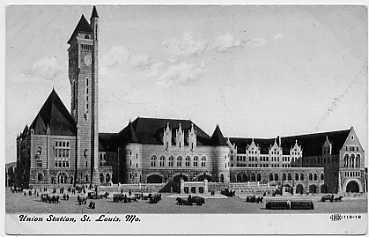
Union Stations Across the U.S.
By Beryl Frank
St. Louis, Missouri
Dan Brown said in the Da Vinci Code, "the inside of Gare Saint-Lazare looked like every other train station in Europe." The same could never be said of the large stations in the U.S. There are Victorian stations, early frame stations and combinations of both all over our maps.
The first Union Station at St. Louis host to trains as early as 1875. Fourteen years later, the Empire design was declared outdated. In 1889, six railroads formed the Terminal Railroad Association of St. Louis (T.R.R.A.). This organization hired the St. Louis architect Theodore C. Link - a native son who was trained in Europe.
Link's finished railway station was huge and resembled a castle from abroad. In 2004, the Baltimore Sun called the station "a Romanesque pile" which opened in 1894 (and closed in 1978).
In the same article, the Sun said that when the country used the railroads for whistle-stop political campaigns, candidates went through St. Louis Union Station to get from coast to coast. Many candidates like Franklin Delano Roosevelt and Harry S. Truman were both seen from the back of a train by the voters.
The year 1940 saw the dedication of the Aloe Plaza featuring a $50,000 fountain display plus 19 bronze figures sculpted by Carl Miles of Sweden. The plaza was named for the late Louis P. Aloe and partially funded by his wife.
Amtrak began operation in 1971 so the great lady depot was still in use then. For some years when Amtrak moved on, the station was not in use. By 1985 with both federal and private money, restoration of this Union Station was complete. The restored station was opened with a six-story hotel, the Harvey Restaurant and the Grand Hall were there, and the latter was a lobby for smaller businesses.
Time and the railroads were very well acquainted. The railroad signal of ALL ABOARD was usually based on timekeepers - from pocket watches for the conductor to the tall clock towers at the top of the depots.

Note the architect's use of points reaching to the sky. The clock tower reaches for the sky as well. [Post card photo circa-1908]

A later view of the station after the fountains were established. [Post card photo circa-1940]
.